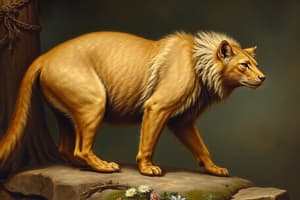Podcast
Questions and Answers
What is a common characteristic action of medium to larger canids when scavenging?
What is a common characteristic action of medium to larger canids when scavenging?
- Begin at the tail and remove hard tissue
- Start at the head and remove soft tissue (correct)
- Chew through the lower limbs first
- Focus on the abdominal cavity only
Which anatomical feature is specifically mentioned as being chewed through by scavengers?
Which anatomical feature is specifically mentioned as being chewed through by scavengers?
- Upper limbs
- Clavicles (correct)
- Pelvic girdle
- Skull
In addition to characteristic tooth marks, which evidence can indicate mammalian scavenger activity at a scene?
In addition to characteristic tooth marks, which evidence can indicate mammalian scavenger activity at a scene?
- Only blood stains
- Caching of bones
- Scat, tracks, and hair (correct)
- Feathers and claw marks
What does the term 'evisceration' refer to in the context of scavenging patterns?
What does the term 'evisceration' refer to in the context of scavenging patterns?
Which of the following is least likely to be a scavenging pattern observed in larger canids?
Which of the following is least likely to be a scavenging pattern observed in larger canids?
Flashcards
Mammalian Scavengers - Signs
Mammalian Scavengers - Signs
Scavenging animals, especially mammals, leave characteristic signs at a carcass that can help identify them.
Teeth Marks
Teeth Marks
Teeth marks on bones can be unique to different species, aiding in identifying scavengers.
Canid Scavenging Pattern - Head First
Canid Scavenging Pattern - Head First
Wolf-like scavengers (e.g., coyotes, wolves) often begin feeding at the head and remove soft tissues first.
Canids - Clavicle Damage
Canids - Clavicle Damage
Signup and view all the flashcards
Canids - Evisceration
Canids - Evisceration
Signup and view all the flashcards
Study Notes
Mammalian Scavenger Behavior
- Scavenging mammals exhibit distinct tooth marks and patterns of carcass consumption.
- Evidence of scavenging can include scat, tracks, and hair.
Canid Scavenging Patterns
- Medium/larger canids often begin scavenging from the head, removing soft tissues progressively.
- Clavicles are commonly chewed through.
- Upper limbs and pectoral girdle are targeted next.
- Thoracic, abdominal, and pelvic cavities are frequently eviscerated.
- Lower limb bones are typically disarticulated (separated).
Studying That Suits You
Use AI to generate personalized quizzes and flashcards to suit your learning preferences.




